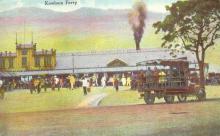13 Jul 1942, John Charter's wartime journal
Primary tabs
((More about the Americans' departure:)) One of the Star Ferry boats, accompanied by several launches had arrived during the morning, for the purpose of ferrying the passengers to the Asama. The sound of its siren, or hooter, was so familiar that it sent a pang through me. During the morning there arrived also some 50 Americans from town. They came in by bus and were made up of all the American bankers (all bank men have been kept in town, all British and Americans) and Chinese with American passports. They were the first to board the ferry.
The Stanley Americans (about 320 in number) had had their baggage inspected on the previous day. I watched the Japanese gendarmes going through some of the kit, and they were pretty thorough about it. No one was allowed to take any written matter and no photographs with Hong Kong scenery in them. One of the Maryknoll Fathers had spent a great deal of time writing out a series of sermons, and the poor beggar was forced to part with them. He left them in the care of one of the Americans remaining behind, in the hope that, one day, they will be returned to him. If ever we are evacuated or repatriated, it seems that I and this diary will be forced to part-company. I shall have to try and hide it somewhere on the off chance that one day I shall return and retrieve it. That goes for Yvonne’s recipe book as well.
The last of the Americans was ferried from the small pier to the Star Ferry launch and the launch itself weighed anchor and set off for the Asama at about 4.30. The hillside was quite crowded with British and the remaining Americans, waving farewell to the voyagers.
Every person had been allowed to take five suit cases, but no trunks or boxes were permitted. Yvonne and I have 3 suit cases and two wicker baskets between us! The rest of our goods have alas perished. Well, good luck to them and a happy landing. They proceed first to Lorenzo Marques in Portuguese East Africa, stopping for a day at Saigon to pick up a few more Americans there. At Lorenzo Marques they will re-embark upon an American ship and proceed to New York via the Cape of Good Hope - 3/4 of the way round the globe instead of simply crossing the Pacific. The Asama Maru will then return from Lorenzo Marques with the Japanese Nationals from America that have been exchanged for the Americans. We hear that the Conte Verde (the large Italian ship that Yvonne and I saw at anchor at Shanghai 18 months ago) is accompanying the Asama to L.M. with Americans from Shanghai. However, this is only hearsay. So also is the news that two or three Japanese are being exchanged for one American.
Somehow 50 Americans have elected to remain in Stanley. There are some Nuns and quite a few missionaries amongst them. Why they should choose to remain here I don’t know, because this is a completely unproductive existence. Perhaps they think the war will soon be over. Some of them may be business men with their own businesses, and they may have decided to stay here so as to be on the spot when trade and business starts again. This war here will have smashed many small businesses; probably some big business houses too.
Since the departure of the Americans there has been a great deal of re-billeting going on. The remaining Americans have moved right up to one end of the former American blocks and occupy three flats there. That now leaves 9 big flats and 3 smaller flats vacant; also the European Warders’ Club premises that had been occupied by the Americans.
The billeting committee is aiming at 6 people in the large room (living room) in each flat, 4 for the dining room, 5 in each of the two bedrooms and 2 in each of the two servants’ rooms. The small flats have one bedroom only, so the big flats should contain 24 people and the small ones 19. (There were 33 and 2 babies in our two bedroomed flat to begin with!). The aged and infirm and mothers with babies (whose husbands are not in camp) are amongst the first to be moved in, then people from overcrowded rooms, and so on. The rooms in the Indian Quarters are much smaller and have been occupied by 3 and 4 people, 7 per flat. It is hoped to reduce these too. For some reason the Japanese authorities have instructed all single policemen to move from St Stephens to the Indian Quarters, and single men in the Indian Quarters are to take their places at St Stephens. This has caused a lot of upset and confusion. In fact there is such confusion at the moment that no people are being allowed in or out of the hospital till it is all over, as such movements only add to the confusion. Thanks goodness Yvonne and I are staying put. The Bidwells, Isa and Mr Lammert are hoping they will be able to secure a room for four in this block. It will be nice for them if they can, as they will be able to live together as a family.

